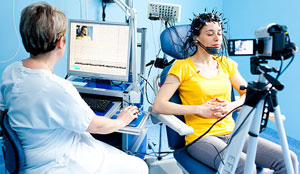Electroencephalogram (EEG)

An electroencephalogram (EEG) is a recording of brain activity. During the test, small sensors are attached to the scalp to pick up the electrical signals produced when brain cells send messages to each other. These signals are recorded by a machine and are looked at by a doctor, later to see if they're unusual. The EEG procedure is usually carried out by a highly trained specialist called a clinical neurophysiologist during a short visit to hospital.
An EEG test records the electrical activity in the brain and it is used to:
- differentiate between types of seizures and to add support to a diagnosis of epilepsy
- assist in the classification of epilepsies and syndromes
- detect or confirm photosensitivity
- detect non-convulsive status epilepticus
- monitor status epilepticus
- assess state in coma
- assess confusional states
- confirm ‘classic’ sporadic CJD
- assess the early stages of vascular events (when a CT scan appears normal)
For the test small contacts are placed on the scalp; the test is painless and there are no after effects. On average it will take between 45 minutes and one and a half hours. During the test patients may be asked to do some deep breathing or to look at a flashing light.
Often the appointment is arranged so that the patient will fall asleep during the recording, which may give additional information to aid diagnosis.

